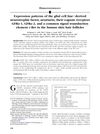Search
forLearn
1 / 1 resultsResearch
5 / 921 resultsresearch Uncomplicated Differentiation of Stem Cells Into Bipolar Neurons and Myelinating Glia
Hair follicles can be used to easily create neurons and glial cells for potential nerve repair.

research Expression Patterns of Glial Cell Line-Derived Neurotrophic Factor, Neurturin, Their Cognate Receptors GFRα-1, GFRα-2, and Common Signal Transduction Element c-Ret in Human Skin Hair Follicles
Certain proteins and their receptors are more active during the growth phase of human hair and could be targeted to treat hair disorders.
research Glia-Derived Steroids Modulate Epileptogenesis in a Model of Temporal Lobe Epilepsy
Neurosteroids from glia cells help control seizure development in epilepsy.

research Differential Expression Levels of Sox9 in Early Neocortical Radial Glial Cells Regulate the Decision Between Stem Cell Maintenance and Differentiation
Sox9 levels in brain stem cells affect whether they stay as stem cells or become neurons.
research Influence of Conditioned Media from Glial Cell Cultures on Uterine Contractility in Rats of Different Ages
Conditioned media from glial cell cultures improved uterine contractions in older rats.
Community Join
2 / 2 resultscommunity Why do people here trust Kevin Mann?
Concerns about finasteride's side effects on neurosteroids and brain health, with skepticism towards Kevin Mann's advice. Users discuss using finasteride, minoxidil, and RU58841 for hair loss, with mixed opinions on their safety and effectiveness.
community Please explain this Minoxidil phenomena
The post discusses the difference in effects of Minoxidil (Min) on scalp and facial hair. The user questions why Min-induced hair growth on the scalp is temporary, while facial hair growth seems permanent, even after stopping Min. They propose theories, including different Min mechanisms on body and facial hair, the role of DHT, and the possibility of not achieving fully terminal hair. The responses include personal experiences and theories about Min's effects on hair growth.